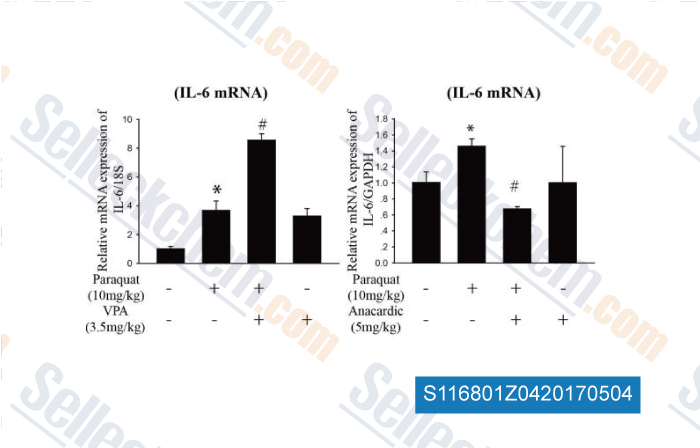|
How to Cite 1. For In-Text Citation (Materials & Methods): 2. For Key Resources Table: |
||
|
Toll Free: (877) 796-6397 -- USA and Canada only -- |
Fax: +1-832-582-8590 Orders: +1-832-582-8158 |
Tech Support: +1-832-582-8158 Ext:3 Please provide your Order Number in the email. We strive to reply to |
Technical Data
| Formula | C8H15NaO2 |
||||||
| Molecular Weight | 166.19 | CAS No. | 1069-66-5 | ||||
| Solubility (25°C)* | In vitro | DMSO | 33 mg/mL (198.56 mM) | ||||
| Water | 33 mg/mL (198.56 mM) | ||||||
| In vivo (Add solvents to the product individually and in order) |
|
||||||
|
* <1 mg/ml means slightly soluble or insoluble. * Please note that Selleck tests the solubility of all compounds in-house, and the actual solubility may differ slightly from published values. This is normal and is due to slight batch-to-batch variations. * Room temperature shipping (Stability testing shows this product can be shipped without any cooling measures.) |
|||||||
Preparing Stock Solutions
Biological Activity
| Description | Valproic Acid sodium is a HDAC inhibitor by selectively inducing proteasomal degradation of HDAC2, used in the treatment of epilepsy, bipolar disorder and prevention of migraine headaches. Valproic acid induces Notch1 signaling in small cell lung cancer (SCLC) cells. Valproic acid is under investigation for treatment of HIV and various cancers. Valproic acid (VPA) induces autophagy and mitophagy by upregulation of BNIP3 and mitochondrial biogenesis by upregulating PGC-1α. | ||||
|---|---|---|---|---|---|
| Targets |
|
||||
| In vitro | Valproic acid acts through a distinct pathway that involves direct inhibition of histone deacetylase (IC(50) for HDAC1 = 0.4 mM). Valproic acid mimics the histone deacetylase inhibitor trichostatin A, causing hyperacetylation of histones in cultured cells. Valproic acid, like trichostatin A, also activates transcription from diverse exogenous and endogenous promoters. Valproic acid and trichostatin A have remarkably similar teratogenic effects in vertebrate embryos, while non-teratogenic analogues of valproic acid do not inhibit histone deacetylase and do not activate transcription. [1] Valproic acid induces proliferation of peroxisomes in the rodent liver. Valproic acid at a concentration of 1 mM induces relief of this repression by Gal4 fusions of N‐CoR, TR or PPARδ in a cell line expressing the ligand‐binding domain of PPARδ fused to the DNA‐binding domain of the glucocorticoid receptor (GR) together with a GR‐controlled reporter gene. Valproic acid induces accumulation of hyperacetylated histone and inhibits HDAC activity. Valproic acid induces a specific type of differentiation characterized by reduced proliferation, morphological alterations, marker gene expression and particularly the accumulation of the AP-2 transcription factor as a potential marker of neuronal or neural crest cell-like differentiation in F9 teratocarcinoma cells. Valproic acid impairs cell proliferation or survival as indicated by decreased incorporation of [3H]thymidine in F9 and P19 teratocarcinoma cells. [2] |
||||
| In vivo | Valproic acid delays growth of the primary tumors in the MT‐450 rat breast cancer model. [2] |
Protocol (from reference)
| Cell Assay: |
|
|---|---|
| Animal Study: |
|
References
|
Customer Product Validation

-
, 2011 , Dr. Zhang of Tianjin Medical University

-
Data from [ , , Front Immunol, 2017, 7:696 ]
Selleck's Valproic Acid sodium Has Been Cited by 36 Publications
| Unveiling the role of HP1α-HDAC1-STAT1 axis as a therapeutic target for HP1α-positive intrahepatic cholangiocarcinoma [ J Exp Clin Cancer Res, 2024, 43(1):152] | PubMed: 38812060 |
| Propafenone facilitates mitochondrial-associated ferroptosis and synergizes with immunotherapy in melanoma [ J Immunother Cancer, 2024, 12(11)e009805] | PubMed: 39581704 |
| Periplanta americana extract regulates the Th17/Treg cell balance via Notch1 in ulcerative colitis [ Front Pharmacol, 2024, 15:1534772] | PubMed: 39911826 |
| Oxidative stress mediated by the TLR4/NOX2 signalling axis is involved in polystyrene microplastic-induced uterine fibrosis in mice [ Sci Total Environ, 2022, 838(Pt 2):155825] | PubMed: 35597360 |
| TGFβR-1/ALK5 inhibitor RepSox induces enteric glia-to-neuron transition and influences gastrointestinal mobility in adult mice [ Acta Pharmacol Sin, 2022, 10.1038/s41401-022-00932-4] | PubMed: 35794374 |
| Human forebrain organoids reveal connections between valproic acid exposure and autism risk [ Transl Psychiatry, 2022, 12(1):130] | PubMed: 35351869 |
| Generation of human blastocyst-like structures from pluripotent stem cells [ Cell Discov, 2021, 7(1):81] | PubMed: 34489415 |
| HDAC inhibitors improve CRISPR-mediated HDR editing efficiency in iPSCs [ Sci China Life Sci, 2021, 10.1007/s11427-020-1855-4] | PubMed: 33420926 |
| Exposure of Microglia to Interleukin-4 Represses NF-κB-Dependent Transcription of Toll-Like Receptor-Induced Cytokines [ Front Immunol, 2021, 12:771453] | PubMed: 34880868 |
| Axitinib and HDAC Inhibitors Interact to Kill Sarcoma Cells [ Front Oncol, 2021, 11:723966] | PubMed: 34604061 |
RETURN POLICY
Selleck Chemical’s Unconditional Return Policy ensures a smooth online shopping experience for our customers. If you are in any way unsatisfied with your purchase, you may return any item(s) within 7 days of receiving it. In the event of product quality issues, either protocol related or product related problems, you may return any item(s) within 365 days from the original purchase date. Please follow the instructions below when returning products.
SHIPPING AND STORAGE
Selleck products are transported at room temperature. If you receive the product at room temperature, please rest assured, the Selleck Quality Inspection Department has conducted experiments to verify that the normal temperature placement of one month will not affect the biological activity of powder products. After collecting, please store the product according to the requirements described in the datasheet. Most Selleck products are stable under the recommended conditions.
NOT FOR HUMAN, VETERINARY DIAGNOSTIC OR THERAPEUTIC USE.
